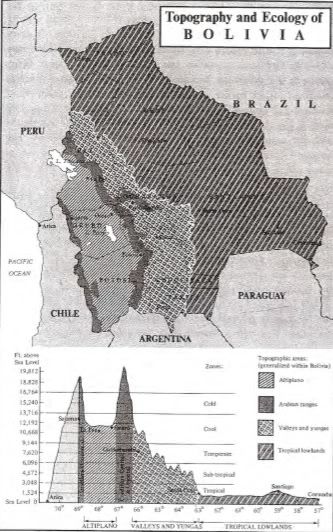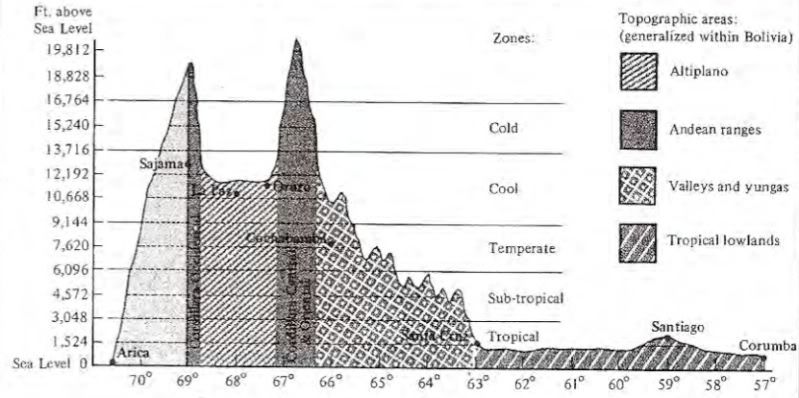Let me begin by providing the same map from the previous diary:

And a close-up (click to make larger):

And a timeline:
- 21,000 years ago: First humans arrived
- 8000 BC: End of last ice age
- 2500 BC: Settled village agriculture, increased population density, more complex social organization
- 1800 BC: First pottery
- 800 BC-100 BC: "Chavin" culture (north of Titicaca)
- 100 BC: Discovery of bronze
- 100 AD: Tiahuanaco culture begins just south of Lake Titicaca
- 600: Tiahuanaco culture spreads beyond local site
- 1000: Rapid expansion of Tiahuanaco
- 1200: Collapse of Tiahuanaco
- Late 1100s-1500s: Aymara dominates central highlands of Bolivia
- Late 1400s: Expansion of Incan (Quechuan) empire
- 1500s: Arrival of Spanish
Around 100 AD, a culture emerged at Tiahuanaco, about 30 mi south of Lake Titicaca at an altitude of 13,120 ft. Klein describes it as "an advanced agricultural settlement with pottery and metal objects..." Tiahuanaco stayed centered around this local site for some 500 years, then expanded starting around 600 AD, expanded rapidly after 1000 AD, and then suddenly collapsed after 1200 AD. Klein says "The most southern of the pre-Columbian Andean empires, it was also one of the few highland ones." Initially, it was thought that the Tiahuanaco empire was accomplished via conquest, but archaeological evidence does not support that theory very well. Some believe that the Tiahuanaco influence was "purely religious." Another thought is that the Tiahuanaco style religious centers are colonies (an idea that makes sense in the context of "vertical ecological integration," which I will discus). The Waru empire (centered around Cuzco, Peru) were contemporaries of the Tiahuanaco (from 700-1100 AD).
Klein says:
In the highlands, this period is associated with an intensification of agriculture and a major new expansion of terraced farming. it can be assumed that Tiahuanaco civilization was associated with a major increase in the tempo of highland economic and social changes.
Next up are the Aymara, also in the central highlands of Bolivia. Klein says "The development of the Aymara kingdoms marks the beginning of the historic period of Bolivian history." He differentiates between the Tiahuanaco and the Aymara by saying:
The concentration of towns along the lakeshore in open communities, the commonality of pottery styles and decoration, and the concentration on terraced agriculture were now replaced by fortified towns (or pucara) on hilltops well back from the lake, a much more intensive development of cameloid herding culture, and a more localized religion as represented by the chulpas, or local burial and ceremonial houses, in all the communities.
The Aymara were warlike and their empire extended from south of Cuzco in Peru to the northern highlands in Bolivia, centered around Lake Titicaca. They had a complex social structure which organized people into ayllus (kin groupings). Here's where it gets interesting:
Besides the complex socio-political and economic structures which existed in the core highland regions, both kurakas [chiefs] and ayllus also had colonists working for them in different ecological zones. Called mitimaq, these highland colonists were the vital link binding the inter-regional and multi-ecological economy that was so crucial in maintaining the core highland populations. Each ayllu and each nation and its nobility had colonists farming the temperate and semi-tropical valleys. In exchange for highland meats, potatoes, quinoa, and woolen products, these colonist paid with everything from fish and salt from the Pacific coast villages to corn, coca, and fruits from the Yungas and sub-puna valleys. In these distant regions, many colonists co-existed with the local non-Aymara populations.
THAT is vertical ecological integration!
Klein goes on to talk about the Inca, saying:
By the late fifteenth century the numerous Aymara kingdoms found themselves in direct competition with the emerging imperial state of a Quechua-speaking nation in the region of Cuzco north of the lake.
These were the Incas. (The rulers were called Incas, they called their own language Runa Sumi, and in Spanish the language is known as Quechua.) He continues:
In the 1460s, they [the Incas] able to extend their influence over the Aymara kingdoms, which were incapable of united against the Inca threat because of traditional animosities among themselves. That weakness, despite the relative military power of the Aymara - who undoubtedly were the strongest possible contenders to Inca hegemony in the entire highland region - led to the gradual loss of independence for the Aymara kingdoms by the end of that decade.
However, the Incan conquest was not the end of Aymara history. There are still Aymara living today. The Aymara paid tribute to the Incas, who mostly left them alone. The Aymara's lost some (but not all) autonomy after a revolt in 1470.
The Incan empire sounds fascinating, but it was only just "beginning to mature" at the time the Spanish showed up. Klein says:
As officially recounted to the Spaniards, the Inca state was an authoritarian and benevolent organization based on rational principles of equality and justice. Prohibiting private property, the state distributed goods and services by taxing up to two-thirds of the produce of the Andean peasantry.
He continues:
From Ecuador to the southern Bolivian borders, a maze of roads was built which facilitated the easy access of all parts of the empire to Cuzco for man and animals. Thousands of acres of new agricultural lands were created through complex terracing of the steep Andean mountainsides, and vast compounds of warehouses were built to store enormous quantities of non-perishable foodstuffs for the entire population. The empire, thus, functioned as a major distributor of goods and services in a non-market manner and probably created well-being and wealth among all the population unmatched from those times to the present.
Here he notes that people were drafted for short terms of labor and fully compensated for the work they did. He then says:
So efficient was this Inca organization that it proved to be a military power that none could oppose... The Incas were able to wear out their opponents by their numbers, equipment, and persistence... and many societies voluntarily joined the powerful new empire. It was, by the time the Spanish arrived, one of the greatest experiments in human organization that the world has ever seen.
Klein goes on to talk about the limits of the Incan empire, which brings us to an excellent point to end on. Bolivia's lowlands were populated by hunter-gatherers and some people who maintained year round agricultural settlements. I believe from what I've read that the lowlands in the East were not as densely populated as the highlands, but nonetheless, there were enough people there that between them and the climate and ecology of the area, it kept the Incas out.
After the Spanish Conquest and until today, there continues to be a huge split (ethnically, culturally, politically) between the highlands in the west and the lowlands in the east. I'll only be visiting the west, with a slight dip into one of the lowland areas, but keep this political dynamic between east and west in mind because it's important.
No comments:
Post a Comment